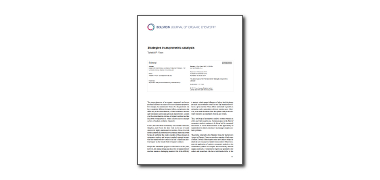Search results
Search for "nucleophilic aromatic substitution (SNAr)" in Full Text gives 13 result(s) in Beilstein Journal of Organic Chemistry.
Identification and removal of a cryptic impurity in pomalidomide-PEG based PROTAC
Beilstein J. Org. Chem. 2025, 21, 407–411, doi:10.3762/bjoc.21.28
- synthesis of iVeliparib-AP6 [5] starts with a nucleophilic aromatic substitution (SNAr) reaction wherein 4-fluorothalidomide (1) reacts with amino-PEG7-OH 2 to give alcohol 3 (Scheme 1). Subsequent alcohol oxidation followed by reductive amination of the resulting aldehyde 4 with veliparib [6][7] provides
5th International Symposium on Synthesis and Catalysis (ISySyCat2023)
Beilstein J. Org. Chem. 2024, 20, 2704–2707, doi:10.3762/bjoc.20.227

- preparation of biologically active compounds [15]. The synthesis was achieved via a sulfonyl group rearrangement driven by the azide–tetrazole equilibrium in quinazolines. The researchers utilized two synthetic pathways to prepare the target compounds. The first pathway involved a nucleophilic aromatic
- substitution (SNAr) reaction between 2-chloro-6,7-dimethoxy-4-sulfonylquinazoline derivatives and NaN3, while the second involved an SNAr reaction between 2,4-dichloro-6,7-dimethoxyquinazoline and alkyl/arylsulfinates, followed by substitution with NaN3. Using this developed methodology, the adrenoblockers
Anion-dependent ion-pairing assemblies of triazatriangulenium cation that interferes with stacking structures
Beilstein J. Org. Chem. 2024, 20, 2567–2576, doi:10.3762/bjoc.20.215

- +) cations, used as visible light fluorescent dyes, have been synthesized via a nucleophilic aromatic substitution (SNAr) reaction with primary alkylamines (e.g., 1a+; Figure 1) [15][16]. The highly planar geometry of the TATA+ core unit induces π–π stacking structures in single-crystal and film states, as
A new platform for the synthesis of diketopyrrolopyrrole derivatives via nucleophilic aromatic substitution reactions
Beilstein J. Org. Chem. 2024, 20, 1933–1939, doi:10.3762/bjoc.20.169
- pentafluorobenzyl bromide, followed by a nucleophilic aromatic substitution (SNAr) with thiols and phenols. This approach is based on the well-established reactivity of perfluoroaromatic compounds in nucleophilic aromatic substitutions [32][33][34][35]. By varying the reaction conditions and the number of
Structure–property relationships in dicyanopyrazinoquinoxalines and their hydrogen-bonding-capable dihydropyrazinoquinoxalinedione derivatives
Beilstein J. Org. Chem. 2024, 20, 1037–1052, doi:10.3762/bjoc.20.92

- could be efficiently transformed to tautomerically active, H-bonding capable 1,4-dihydropyrazino[2,3-b]quinoxaline-2,3-diones (Figure 1b, DPQDs) via nucleophilic aromatic substitution (SNAr) at the ipso-CN positions. Here, the lactim–lactam tautomerization of DPQDs to arrive at the more stable 2,3-dione
Synthesis of benzo[d]imidazo[2,1-b]benzoselenoazoles: Cs2CO3-mediated cyclization of 1-(2-bromoaryl)benzimidazoles with selenium
Beilstein J. Org. Chem. 2019, 15, 2029–2035, doi:10.3762/bjoc.15.199
- probably deprotonation of the heterocyclic rings with a base. Moreover, nucleophilic aromatic substitution (SNAr) reactions between an aryl halide and a selenium reagent such as aryl selenide anion or diaryl diselenide for C(Ar)–Se bond formation using a base have been reported [20][21][22]. However, the
Nitration of 5,11-dihydroindolo[3,2-b]carbazoles and synthetic applications of their nitro-substituted derivatives
Beilstein J. Org. Chem. 2017, 13, 1396–1406, doi:10.3762/bjoc.13.136
- through a conventional mechanism of nucleophilic aromatic substitution (SNAr). On the other hand, conversion of the second nitro group, as well as a similar transformation of compound 10b, can possibly be explained in terms of the radical-nucleophilic aromatic substitution (SRN1), since no other electron
Star-shaped tetrathiafulvalene oligomers towards the construction of conducting supramolecular assembly
Beilstein J. Org. Chem. 2015, 11, 1596–1613, doi:10.3762/bjoc.11.175

- 30 is estimated to be ca. 1000 times higher than that of the neutral fiber (before doping: σrt 3 × 10−6 S cm−1, after doping: σrt 3 × 10−3 S cm−1) [68]. Star-shaped pyrrole-fused TTF oligomers 38–43 were synthesized by nucleophilic aromatic substitution (SNAr) reactions of fluorinated benzenes with
Flow microreactor synthesis in organo-fluorine chemistry
Beilstein J. Org. Chem. 2013, 9, 2793–2802, doi:10.3762/bjoc.9.314
- tripeptide byproduct. Nucleophilic aromatic substitution (SNAr) chemistry contributes to creating useful materials. In 2005, Comer and Organ reported SNAr reactions of 2-fluoronitrobenzene using a flow microreactor system with microwave irradiation (Scheme 9) [69]. Toward making compound-libraries, Schwalbe
Palladium-catalyzed C–N and C–O bond formation of N-substituted 4-bromo-7-azaindoles with amides, amines, amino acid esters and phenols
Beilstein J. Org. Chem. 2012, 8, 2004–2018, doi:10.3762/bjoc.8.227
- 7-azaindole scaffolds appear in various pharmaceutically important molecules (Figure 1), which are very challenging and lengthy to prepare by the traditional methods [40][41]. In general, nucleophilic aromatic substitution (SNAr) reaction of a halo-precursor of 7-azaindole with a large excess of
Exploring chemical diversity via a modular reaction pairing strategy
Beilstein J. Org. Chem. 2012, 8, 1293–1302, doi:10.3762/bjoc.8.147
- nucleophilic aromatic substitution (SNAr) diversification pathway is reported. Eight benzofused sultam cores were generated by means of a sulfonylation/SNAr/Mitsunobu reaction pairing protocol, and subsequently diversified by intermolecular SNAr with ten chiral, non-racemic amine/amino alcohol building blocks
- . Computational analyses were employed to explore and evaluate the chemical diversity of the library. Keywords: benzoxathiazocine 1,1-dioxides; chemical diversity; informatics; nucleophilic aromatic substitution (SNAr); sultams; Introduction The demand for functionally diverse chemical libraries has emerged, as
Directed aromatic functionalization
Beilstein J. Org. Chem. 2011, 7, 1215–1218, doi:10.3762/bjoc.7.141

- extent, nucleophilic aromatic substitution (SNAr) [2][6][7] reactions as taught to many generations of students in their first organic chemistry courses [8] (Figure 1). Being less steeped in history, radical nucleophilic substitution (SRN1) [9] and vicarious nucleophilic substitution (VNS) [10][11][12
Perhalogenated pyrimidine scaffolds. Reactions of 5-chloro- 2,4,6-trifluoropyrimidine with nitrogen centred nucleophiles
Beilstein J. Org. Chem. 2008, 4, No. 22, doi:10.3762/bjoc.4.22
- desirable process but one of the most difficult to achieve in practice. Pyrimidines are electron-deficient aromatic systems and, when halogenated, become very useful substrates for a variety of nucleophilic aromatic substitution (SNAr) processes [9] and, since numerous chloropyrimidines are commercially


















































































































